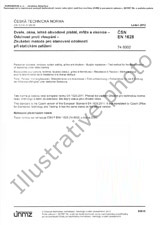We need your consent to use the individual data so that you can see information about your interests, among other things. Click "OK" to give your consent.
ČSN ETSI EN 302217-3-V2.2.1 (878595)
Fixed Radio Systems; Characteristics and requirements for point-to-point equipment and antennas; Part 3: Equipment operating in frequency bands where both frequency coordinated or uncoordinated deployment might be applied; Harmonized EN covering the essential requirements of article 3.2 of the R&TTE Directive
STANDARD published on 1.9.2014
The information about the standard:
Designation standards: ČSN ETSI EN 302217-3-V2.2.1
Classification mark: 878595
Catalog number: 95991
Publication date standards: 1.9.2014
SKU: NS-174560
The number of pages: 68
Approximate weight : 204 g (0.45 lbs)
Country: Czech technical standard
Category: Technical standards ČSN
The category - similar standards:
Radio relay and fixed satellite communications systemsAerials
Annotation of standard text ČSN ETSI EN 302217-3-V2.2.1 (878595):
V2.2.1
The present document specifies the essential requirements for point-to-point Digital Fixed Radio Systems (DFRS) operating in higher frequency bands, which propagation characteristics might be suitable for different simplified frequency planning (see example) rather than conventional link-by-link coordinated deployment.
This would imply that administrations may apply either no co-ordination at all (i.e. the band usage is free and the user is responsible for detecting a suitable interference-free operating frequency) or simplified co-ordination procedures based on the knowledge of existing links (e.g. through a public national data base) so that the impact of a possible new link could be evaluated on the basis of budgetary considerations of typical equipment receiver performances (which will not be considered related to essential requirements of article 3.2 of R&TTE Directive [1]).
The bands in the scope of the present document, to which these frequency assignment procedures apply, are specifically referred in annexes UA through UC where the applicable equipment requirements are reported.
EXAMPLE: The frequency band 58 GHz is proposed to be used by various technologies for uncoordinated use of the band. Besides the RF-channel selection procedure, specified in clause 4.2 to avoid unacceptable interference situations, this band, and those above up to ~63 GHz, also benefits from the high and stable atmospheric attenuation which suppresses efficiently distant interferers (about 10 dB/km to 15 dB/km at sea level), refer to Recommendation ITU-R P.676 [i.13].
The present document is intended to cover the provisions of Directive 1999/5/EC [1] (R&TTE Directive) regarding article 3.2, which states that ". radio equipment shall be so constructed that it effectively uses the spectrum allocated to terrestrial/space radio communications and orbital resources so as to avoid harmful interference".
In addition to the present document, other ENs that specify technical requirements in respect of essential requirements under other parts of article 3 of the R&TTE Directive [1] will apply to equipment within the scope of the present document.
NOTE: A list of such ENs is included on the web site /> In order to technically cover different market and network requirements, with an appropriate balance of performance to cost and effective and appropriate use of the radio spectrum, the present document, together with EN 302 217-4-2 [10], offers system types and antennas alternatives, for selection by administrations, operators and manufacturers dependent on the desired use of the radio spectrum and network/market requirements, those options include:
- " channel separation alternatives (as provided by the relevant CEPT Recommendation);
- " implemented procedure for free radio channel selection;
- " antenna directivity class alternatives (for different network density requirement).
The present document is mainly intended to cover fixed radio equipment without integral antennas. However, it also applies to fixed radio systems products with integral antennas, for which all the technical requirements included in the present document and in EN 302 217-4-2 [10] apply. For more background information on the equipment and antenna parameters here identified as relevant to article 3.2 of R&TTE Directive [1] see EG 201 399 [i.2] and TR 101 506 [i.7].
For the purposes of the present document two equipment Types are specified, when appropriate, depending on specific network requirements:
- " Type A: Digital equipment which apply the standardized automatic RF-channel selection procedure (see clause 4.2) for interference avoidance and error performance enhancement.
- " Type B: Equipment not required to have automatic RF-channel selection procedure
Preview of the standard ČSN ETSI EN 302217-3-V2.2.1 (878595)
Similar standards:
1.12.1999
1.11.1999
1.11.1999
1.11.1999
1.3.2000
1.7.2000
We recommend:
Updating of laws
Do you want to be sure about the validity of used regulations?
We offer you a solution so that you could use valid and updated legislative regulations.
Would you like to get more information? Look at this page.




 Cookies
Cookies
